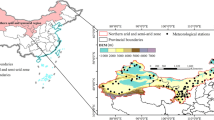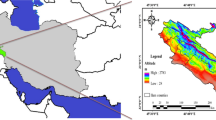Abstract
Drought as a natural disaster is one of the human’s ecological, hydrological, agricultural, and economic concerns. In this study, multiscale intelligence methods were proposed for drought severity detection and mapping in the northwest part of Iran for the years of 2007 to 2020. In the modeling process two scenarios were considered and in-situ and remote sensing datasets were adopted with two machine learning models namely M5 Pruning tree (M5P) and Random Forest (RF). In the first scenario, the in-situ datasets including the precipitation, relative humidity, evaporation, and temperature were used as inputs of the intelligence models to assess drought severity in terms of the Standardized Precipitation Index. In the second scenario, the SM2RAIN-ASCAT precipitation product and Normalized Difference Vegetation Index (NDVI) and Land Surface Temperature (LST) products of the MODIS were considered as inputs. During the drought severity modeling process, the input time series were first broken down into several subseries via the Variational Mode Decomposition; then, the most effective subseries were selected and imposed into the M5P and RF as inputs. Also, the potential of the relatively new TemperatureVegetation Water Stress Index (T-VWSI), which has developed based on the NDVI and LST, was assessed in drought severity monitoring. The results proved the appropriate efficiency of the proposed multiscale methods in effectively detecting drought severity. Also, it was observed that the T-VWSI could be successfully used for detecting drought occurrences in areas without meteorological datasets.







Similar content being viewed by others
Availability of data and material
The used datasets are obtained from Iranian Meteorological Organization and satellite products.
Code availability
Not applicable.
References
Abbasi A, Khalili K, Behmanesh J, Shirzad A (2019) Drought monitoring and prediction using SPEI index and gene expression programming model in the west of Urmia Lake. Theor Appl Climatol 138(1):553–567
Abdoos AA (2016) A new intelligent method based on combination of VMD and ELM for short term wind power forecasting. Neurocomputing 203:111–120
Abdulrazzaq ZT, Hasan RH, Aziz NA (2019) Integrated TRMM data and standardized precipitation index to monitor the meteorological drought. Civ Eng J 5(7):1590–1598
AghaKouchak A, Farahmand A, Melton FS, Teixeira J, Anderson MC, Wardlow BD, Hain CR (2015) Remote sensing of drought: progress, challenges and opportunities. Rev Geophys 53:452–480
Anbazhagan S, Paramasivam CR (2016) Statistical correlation between land surface temperature (LST) and vegetation index (NDVI) using multi-temporal landsat TM data. Int J Earth Sci Eng 5(1):333–346
Belal AA, El-Ramady HR, Mohamed ES, Saleh AM (2014) Drought risk assessment using remote sensing and GIS techniques. Arab J Geosci 7(1):35–53
Biau G, Scornet E (2015) A random forest guided tour. arXiv:151105741 [math, stat]
Breiman L (2001) Random forests. Mach Learn 45:5–32. https://doi.org/10.1023/A:1010933404324
Brocca L, Ciabatta L, Massari C, Moramarco T, Hahn S, Hasenauer S, Kidd R, Dorigo W, Wagner W, Levizzani V (2014) Soil as a natural rain gauge: estimating global rainfall from satellite soil moisture data. J Geophys Res Atmos 119:5128–5141
Brocca L, Filippucci P, Hahn S, Ciabatta L, Massari C, Camici S, Schüller L, Bojkov B, Wagner W (2019) SM2RAIN-ASCAT (2007–2018): global daily satellite rainfall data from ASCAT soil moisture observations. Earth Syst Sci Data 11:1583–1601
Guo H, Bao A, Liu T, Ndayisaba F, He D, Kurban A, De Maeyer P (2017) Meteorological drought analysis in the Lower Mekong Basin using satellite-based long-term CHIRPS product. Sustainability 9(6):901
Han Y, Li Z, Huang C, Zhou Y, Zong S, Hao T, Niu H, Yao H (2020) Monitoring droughts in the Greater Changbai Mountains using multiple remote sensing-based drought indices. Remote Sens 12(3):530
He X, Luo J, Zuo G, Xie J (2019) Daily runoff forecasting using a hybrid model based on variational mode decomposition and deep neural networks. Water Resour Manag 33(4):1571–1590
Huang N, Chen H, Cai G, Fang L, Wang Y (2016) Mechanical fault diagnosis of high voltage circuit breakers based on variational mode decomposition and multi-layer classifier. Sensors 16(11):1887
Jehanzaib M, Sattar MN, Lee JH, Kim TW (2020) Investigating effect of climate change on drought propagation from meteorological to hydrological drought using multi-model ensemble projections. Stoch Environ Res Risk Assess 34:7–21
Jeong HG, Ahn JB, Lee J, Shim KM, Jung MP (2020) Improvement of daily precipitation estimations using PRISM with inverse-distance weighting. Theor Appl Climatol 139(3):923–934
Katiraie-Boroujerdy PS, Nasrollahi N, Hsu K, Sorooshian S (2016) Quantifying the re liability of four global datasets for drought monitoring over a semi-arid region. Theor Appl Climatol 123:387–398
Khan N, Sachindra DA, Shahid S, Ahmed K, Shiru MS, Nawaz N (2020) Prediction of droughts over Pakistan using machine learning algorithms. Adv Water Resour 139:103562
Kikon A, Deka PC (2022) Artificial intelligence application in drought assessment, monitoring and forecasting: a review. Stoch Environ Res Risk Assess 36:1197–1214
Mahmoudi P, Rigi A, Kamak MM (2019) Evaluating the sensitivity of precipitation-based drought indices to different lengths of record. Hydrology 579:124181
McKee TB, Doesken NJ, Kleist J (1993) The relationship of drought frequency and duration to time scales. In: Proceedings of the 8th conference on applied climatology, pp 179–184
Melesse AM, Khosravi K, Tiefenbacher JP, Heddam S, Kim S, Mosavi A, Pham BT (2020) River water salinity prediction using hybrid machine learning models. Water 12:295
Mirabbasi R, Anagnostou EN, Fakheri-Fard A, Dinpashoh Y, Eslamian S (2013) Analysis of meteorological drought in northwest Iran using the Joint Deficit Index. Hydrol 492:35–48
Misra S, Li H (2020) Chapter 9-Noninvasive fracture characterization based on the classification of sonic wave travel times. In: Misra S, Li H, He J (eds) Machine learning for subsurface characterization. Gulf Professional Publishing, New York, pp 243–278
Mokarram M, Pourghasemi HR, Hu M, Zhang H (2021) Determining and forecasting drought susceptibility in southwestern Iran using multi-criteria decision-making (MCDM) coupled with CA-Markov model. Sci Total Environ 781:146703
Mokhtarzad M, Eskandari F, Vanjani NJ, Arabasadi A (2017) Drought forecasting by ANN, ANFIS, and SVM and comparison of the models. Environ Earth Sci 76(21):1–10
Noorisameleh Z, Gough WA, Mirza M (2021) Persistence and spatial-temporal variability of drought severity in Iran. Environ Sci Pollut Res 28(35):48808–48822
Quan Q, Gao S, Shang Y, Wang B (2021) Assessment of the sustainability of Gymnocypris eckloni habitat under river damming in the source region of the Yellow River. Sci Total Environ 778:146312
Quinlan JR (1992) Learning with continuous classes. World Scientific, Singapore, pp 343–348
Roushangar K, Alizadeh F (2018) Entropy-based analysis and regionalization of annual precipitation variation in Iran during 1960–2010 using ensemble empirical mode decomposition. Hydroinform 2(2):468–485
Roushangar K, Ghasempour R, Kirca VO, Demirel MC (2021) Hybrid point and interval prediction approaches for drought modeling using ground-based and remote sensing data. Hydrol Res 52(6):1469–1489
Rulinda CM, Bijker W, Stein A (2010) Image mining for drought monitoring in eastern Africa using Meteosat SEVIRI data. Int J Appl Earth Obs Geoinf 12:563–568
Song C, Yue C, Zhang W, Zhang D, Hong Z, Meng L (2019) A remote sensing-based method for drought monitoring using the similarity between drought eigenvectors. Int J Remote Sens 40:1–8856
Sruthi S, Aslam MM (2015) Agricultural drought analysis using the NDVI and land surface temperature data; a case study of Raichur district. Aquat Procedia 4:1258–1264
Wanders N, Bierkens MFP, de Jong SM, de Roo A, Karssenberg D (2014) The benefits of using remotely sensed soil moisture in parameter identification of large-scale hydrological models. Water Resour Res 50:6874–7689
Wang Y, Witten IH (1996) Induction of model trees for predicting continuous classes. In: Proceedings of the Poster Papers of the European Conference on Machine Learning, Prague, Czech Republic, pp 1–12
Zare M, Drastig K, Zude-Sasse M (2019) Tree water status in apple orchards measured by means of land surface temperature and vegetation index (LST-NDVI) trapezoidal space derived from Landsat 8 satellite images. Sustainability 12(1):70
Zhang F, Zhang LW, Wang XZ, Hung JF (2013) Detecting agro-droughts in Southwest of China using MODIS satellite data. J Integr Agric 12(1):159–168
Zhang J, Mu Q, Huang J (2016) Assessing the remotely sensed Drought Severity Index for agricultural drought monitoring and impact analysis in North China. Ecol Indic 63:296–309
Zhang R, Chen ZY, Xu LJ, Ou CQ (2019) Meteorological drought forecasting based on a statistical model with machine learning techniques in Shaanxi province, China. Sci Total Environ 665:338–346
Acknowledgements
This research is supported by the research grant of the University of Tabriz (research number: 78).
Funding
Funding was provided by University of Tabriz (78).
Author information
Authors and Affiliations
Contributions
RG Project administration, Investigation, Data Curation, Methodology, Writing. MTA Conceptualization, Supervision, Methodology, Review and Editing. VSOK Formal analysis, Review and Editing. KR Formal analysis, Review and Editing.
Corresponding author
Ethics declarations
Conflict of interest
The authors declare no conflicts of interest / competing interests.
Ethics approval
Not applicable.
Consent to participate
Not applicable.
Consent for publication
Not applicable.
Additional information
Publisher's Note
Springer Nature remains neutral with regard to jurisdictional claims in published maps and institutional affiliations.
Rights and permissions
Springer Nature or its licensor (e.g. a society or other partner) holds exclusive rights to this article under a publishing agreement with the author(s) or other rightsholder(s); author self-archiving of the accepted manuscript version of this article is solely governed by the terms of such publishing agreement and applicable law.
About this article
Cite this article
Ghasempour, R., Aalami, M.T., Kirca, V.S.O. et al. Remote sensing-based drought severity modeling and mapping using multiscale intelligence methods. Stoch Environ Res Risk Assess 37, 889–902 (2023). https://doi.org/10.1007/s00477-022-02324-w
Accepted:
Published:
Issue Date:
DOI: https://doi.org/10.1007/s00477-022-02324-w




